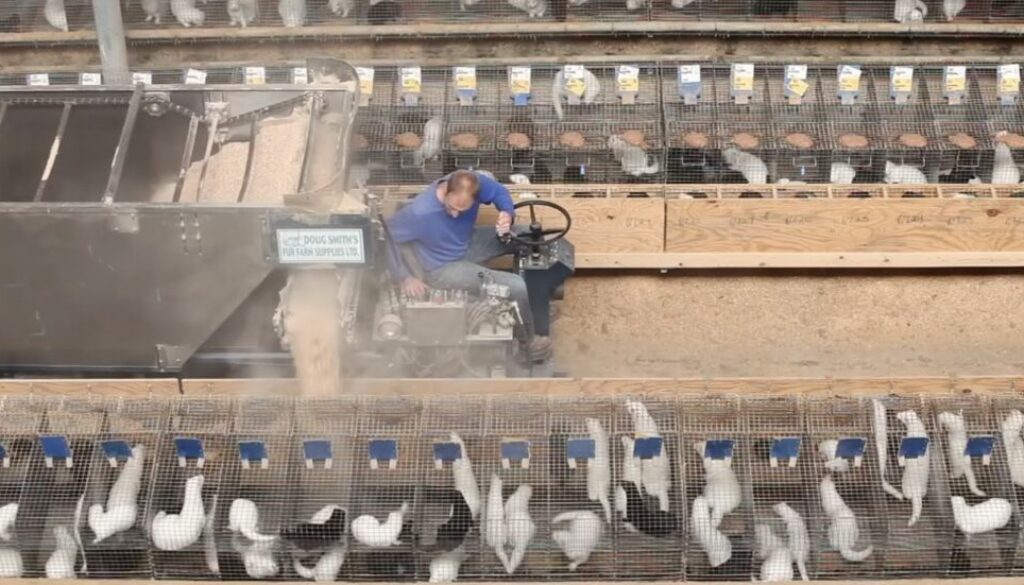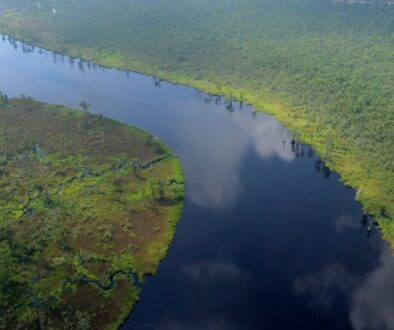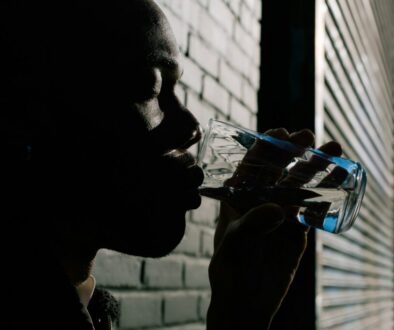An old battle over fur farming heats up with new environmental twist
Wearing fur has long been a controversial choice in the United States, with a large roster of fashion brands embracing bans on fur garments on the grounds that the practice is cruel to the animals farmed for their pelts. But a new twist on the issue has been gaining momentum and spurring debate over the impacts of mink farming on human and environmental health.
Earlier this year, California implemented the first state ban on the sale and manufacturing of fur products, including coats, trim on hooded jackets, and pompoms for hats and gloves. Many US cities and towns have banned fur sales, and in June, US Rep Adriano Espaillat, a Democrat from New York, introduced a bill that that would pay mink farmers to shutter their operations and create a nationwide ban on farming the small animals whose silky, sleek coats are coveted for use in high-end attire.
The aim of the federal bill is to reduce the chances that mink farming could trigger outbreaks of viruses that harm humans, an issue that triggered international concerns during the Covid-19 pandemic. Proponents of the measure say they hope it will be included in the upcoming Farm Bill.
Fur farming has also become a subject of intense debate over its environmental impact, with opponents arguing its practices contribute to water pollution and harmful climate change.
Fur farming takes “a huge toll on the environment as well as animals and public health,” said PJ Smith, director of fashion policy for the Humane Society of the United States.
A Humane Society International (HSI) report published last month determined that producing fur releases more greenhouse gases than producing the same quantity of other materials used to manufacture clothing, including cotton, acrylic, and polyester.
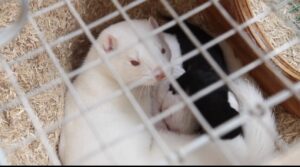
In contrast, proponents argue fur is a natural and enduring alternative to many fast fashion textiles, including faux fur, which is made from petroleum and can take over 1,000 years to break down.
“I have a mink coat that is 45 years old and it’s still in mint condition,” said Wisconsin fur farmer Valerie Zimbal, whose fifth-generation family-run business houses about 250,000 mink. “America’s [fashion] is throwaway fashion. You wear it for a season and then it’s garbage by the end. A real fur garment lasts a really long time and it’s a natural fiber.”
Some industry backers warn that measures to ban fur farming could set the stage for the demise of other forms of farming.
“If passed, [the bill] could set a dangerous precedent, allowing similar justifications to phase out other animal agricultural sectors,” said Challis Hobbs, executive director of Fur Commission USA, an organization that represents US mink farmers and certifies their products.
“The potential implications of this bill are severe; it could result in an unnecessary confiscation of family-owned property, halt hundreds of millions of dollars being injected into rural communities that depend on these agricultural operations, and end families’ legacies and their right to farm based on unfounded fears,” Hobbs said.
Fur in decline
One point that is not subject to debate is the steady decline seen in US fur production.
In a report issued earlier this month, the United States Department of Agriculture (USDA) said US mink pelt production dropped 15% from 2021 to 2022, when 1.33 million pelts were produced. That was down from 3.75 million pelts in 2015, according to the report. There are only about 100 mink fur farms left in the US, according to industry experts.
The shrinking size of the market comes as fur-free policies have taken root at numerous well-known fashion brands, including Gucci, Balenciaga, Prada, Armani, Jimmy Choo, and Versace. One major luxury brand still selling fur is LVMH, which includes the brands Louis Vuitton, Fendi, Dior, and Marc Jacobs.
“It’s been a wave that started around 2015 and it’s just taken off from there,” said Smith.
In addition to the push to eradicate US fur farming, similar moves have been made in many places across Europe. The United Kingdom banned fur farming in 2003 and has since been joined by France, Belgium, Italy, and the Netherlands. In 2021 Israel became the first country in the world to ban the sale of fur clothing.
Over 1.5 million people have signed the Fur Free Europe European Citizens’ Initiative, which calls for a ban on both fur farming and the sale of fur products in Europe.
Globally, about 100 million animals are still bred for their fur, however, according to HSI. Mink are the most commonly raised, followed by foxes and raccoon dogs, which are relatives of foxes.
Opponents of the practice say many of the animals are subject to abuse. The group People for the Ethical Treatment of Animals (PETA) alleged in 2016 that one large fur farm in Wisconsin kept mink and foxes in filthy cages and terrorized the animals by spraying them with a loud pressure washer. Unlike animals farmed for food, species farmed for their fur in the US are not protected under federal laws such as the Humane Methods of Slaughter Act.
“Green” or greenwashing?
The clothing sector accounts for 2-8% of global carbon emissions, with people buying more clothing but keeping it half as long as they 15 years ago, according to the United Nations Environment Programme.
“We have to stop polluting ourselves by the use of plastics and polyester and petroleum products and really gear towards more natural fibers that could be farm-raised by certified, audited, and inspected farms,” said Charles Ross, head of sustainability at the auction house Saga Furs. “When a fur coat finally goes to a landfill, it biodegrades at the same speed as a leaf.”
But opponents of the industry view “sustainable fur” as a greenwashing tactic designed to improve fur’s public image. Smith from the Humane Society of the US said he first noticed a swing toward sustainability messaging in 2015 or 2016.
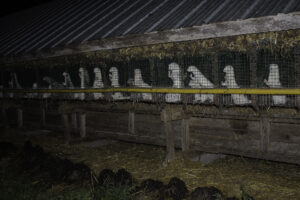
“It was really interesting to see the tactics switch when they were losing the animal welfare argument,” said Smith.
Undercutting the idea of fur as a “natural” material, a 2011 report by the animal welfare group Four Paws found hazardous chemicals, including formaldehyde, in “worryingly high concentrations” in many of the furs it examined. A 2018 analysis by the groups Act Asia and Fur Free Alliance found chemical residues above permitted levels in the six fur garments they purchased in China.
And, in an analysis of the HSI report released in June, researchers said they found that fur production resulted in higher air emissions, greenhouse gas emissions, water consumption, and water pollution per kilogram than materials including polyester, cotton, and acrylic. The report determined that the carbon footprint of mink fur is 31 times than that of the same amount of cotton, 25 times higher than acrylic, and 25 times higher than polyester.
“While all materials have a carbon footprint to some degree, our report shows just how large an environmental impact fur production has and dispels any myths about its green credentials,” said Claire Bass, senior director of campaigns and public affairs for HSI in the UK, in a press release.
Producing just one kilogram of mink fur requires 563 kilograms of food such as chicken or fish, according to a 2011 report on Dutch mink farms conducted by an independent consulting company in Europe.
As well, there is evidence that emissions from mink manure contribute to water contamination in areas near fur farms.
“The mink farms are clearly having an impact on water quality,” said Jules Blais, an environmental pollutants researcher at the University of Ottawa who spent three years studying contaminants in lakes around Nova Scotia, Canada’s fur farming capital. Blais found that lakes located near mink farms had high levels of phosphorus and nitrogen, which led to algal blooms. When they grow out of control, the plants deplete oxygen, choking aquatic ecosystems.
As well, Blais said mercury is a concern.
“There was an indication that lakes that were adjacent to mink farms had higher mercury than lakes that were not adjacent to mink farms,” he said. A 2022 study he co-authored found mercury, the industrial chemicals polychlorinated biphenyl and pesticides in mink feed and mink waste.
COVID-19 concerns
Beyond the environmental worries are concerns about connections between human and animal health that were heightened by the Covid-19 pandemic, when the virus infected the animals at farms across the US, Europe, and Canada.
At least 18 US farms and more than 20,000 mink have been affected by COVID-19, according to Alicia Prygoski, a strategic legislative affairs manager at the Animal Legal Defense Fund.
One outbreak occurred in Michigan in 2021 when a taxidermist, his wife, and two mink farm employees caught a unique strain of the virus linked to mink – the first reported instances of animals transmitting SARS-CoV-2 to humans in the US.
Mink, along with white-tailed deer and a type of hamster, are among a few animals that have been found to have the ability to pass the virus to humans. As a result, COVID-19 in mink stand out to scientists as a possible source of new variants.
The Centers for Disease Control and Prevention (CDC), however, wrote in its 2021 guidance for mink farmers and industry workers that it did not see any evidence that mink played a significant role in the spread of SARS-CoV-2 to people.
Farmed mink are also susceptible to other infections from humans, pigs, and birds, including the avian influenza (“bird flu”). Earlier this year, amidst a deadly global bird flu outbreak, mink at a large farm in Spain contracted and quickly spread the virus.
“Historically, with avian flu, mammal-to-mammal transmission has been relatively low,” said Prygoski. “Then suddenly it’s spreading rapidly among mink at this industrial farm. This should be seen as a warning sign that the mink-to-mink spread shows that viruses like avian flu, and like COVID-19, have the potential to mutate in a way that could bring on the next pandemic.”
An eye on the runways
Despite the US industry’s decline, and the environmental and health debates, Charles Ross, head of sustainability at the auction house Saga Furs, doesn’t think fur clothes and accessories will vanish. Ross blames recent production declines on the COVID-19 pandemic and the war in Ukraine, noting that Russia is the world’s second-largest fur market.

“Despite shifts in geographical demand and cyclical markets, the production of mink pelts is falling below the global demand, which is setting up these US family mink farms for a good up market,” said Ross.
“We’re starting to see fur on the runways again in North America,” he added. “We’re seeing a very positive acceptance to fur again in the designer community.”
For Zimbal, the Wisconsin fur farmer, the concerns are baseless. Zimbal said her animals are well cared for. The breeding season begins in March and pregnant mothers give birth by May. The animals are fed with mixes of local cheeses and slaughterhouse scraps that otherwise go to landfills, according to Zimbal. Staff members provide the animals with toys to play with and use sprinklers in the summer to keep the mink cool. The animals are routinely tested for disease, she said.
In December, when the minks’ thick winter coats have grown in, the animals are euthanized with carbon monoxide. The fur is then “harvested” and the bodies are sent to pet food suppliers. In January and February, Zimbal sells the pelts at an international auction where China is the top buyer.
“They’re coming after us because we’re a small industry,” said Zimbal. “Their goal is to make everybody vegan. If you want to be vegan, you don’t want to eat meat, you don’t want to wear leather or fur, more power to you. But if I want to, shouldn’t that be my choice?”
(Featured Image: An employee at Zimbal Mink Farm in Wisconsin feeds the mink and puts fresh shavings into their nest boxes. Photo by Valerie Zimbal.)
 EWG
EWG